
A chocolate chip cookie is a drop cookie that features chocolate chips or chocolate morsels as its distinguishing ingredient. Chocolate chip cookies are claimed to have originated in the United States in 1938, when Ruth Graves Wakefield chopped up a Nestlé semi-sweet chocolate bar and added the chopped chocolate to a cookie recipe; however, historical recipes for grated or chopped chocolate cookies exist prior to 1938 by various other authors.
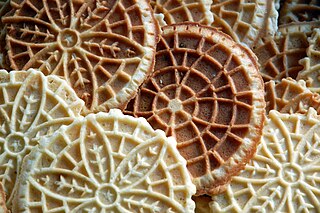
Pizzelle are traditional Italian waffle cookies made from flour, eggs, sugar, butter or vegetable oil, and flavoring. Pizzelle can be hard and crisp or soft and chewy depending on the ingredients and method of preparation. It can be molded into various shapes, including in the tubular shape of cannoli.

Ammonium bicarbonate is an inorganic compound with formula (NH4)HCO3. The compound has many names, reflecting its long history. Chemically speaking, it is the bicarbonate salt of the ammonium ion. It is a colourless solid that degrades readily to carbon dioxide, water and ammonia.
Ammonia solution, also known as ammonia water, ammonium hydroxide, ammoniacal liquor, ammonia liquor, aqua ammonia, aqueous ammonia, or (inaccurately) ammonia, is a solution of ammonia in water. It can be denoted by the symbols NH3(aq). Although the name ammonium hydroxide suggests an alkali with the composition [NH+
4][OH−
], it is actually impossible to isolate samples of NH4OH. The ions NH+
4 and OH− do not account for a significant fraction of the total amount of ammonia except in extremely dilute solutions.
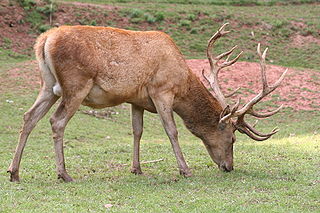
Hartshorn is the antler of male red deer.

Ruth Jones Graves Wakefield was an American chef, best known for her innovations in the baking field. Ruth pioneered the first chocolate chip cookie recipe, an invention many people incorrectly assume was a mistake. Her new dessert, supposedly conceived of as she returned from a vacation in Egypt, is the inspiration behind the massively popular Toll House Chocolate Chip Cookie. Throughout her life, Ruth found occupation as a dietitian, educator, business owner, and published author, most notably of the cookbook, Ruth Wakefield’s, Toll House: Tried and True Recipes.

A chuckwagon or chuck wagon is a horse-drawn wagon operating as a mobile field kitchen and frequently covered with a white tarp, also called a camp wagon or round-up wagon. It was historically used for the storage and transportation of food and cooking equipment on the prairies of the United States and Canada. They were included in wagon trains for settlers and traveling workers such as cowboys or loggers. In modern times, chuckwagons feature in special cooking competitions and events. Chuckwagons are also used in a type of competition known as chuckwagon racing.

Ammonium carbonate is a salt with the chemical formula (NH4)2CO3. Since it readily degrades to gaseous ammonia and carbon dioxide upon heating, it is used as a leavening agent and also as smelling salt. It is also known as baker's ammonia and is a predecessor to the more modern leavening agents baking soda and baking powder. It is a component of what was formerly known as sal volatile and salt of hartshorn, and produces a pungent smell when baked. It comes in the form of a white powder or block, with a molar mass of 96.09 g/mol and a density of 1.50 g/cm3. It is a strong electrolyte.

Rugelach is a filled baked confection originating in the Jewish communities of Poland. It is also a popular treat among Jews in the diaspora.

Mandelbrot, with a number of variant spellings, and called mandel bread or kamish in English-speaking countries and kamishbrot in Ukraine, is a type of cookie found in Ashkenazi Jewish cuisine and popular amongst Eastern European Jews. The Yiddish word mandlbroyt literally means almond bread, a reference to its common ingredient of almonds. It is typically formed by baking a loaf which is then cut into small slabs and twice-baked in order to form a crunchy exterior. The cookies were popular in Eastern Europe among rabbis, merchants and other itinerant Jews as a staple dessert that kept well.
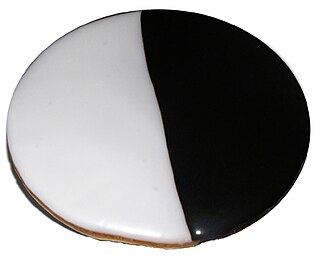
Black-and-white cookies, half-and-half cookies, and half-moon cookies are similar round cookies iced or frosted in two colors, with one half vanilla and the other chocolate. They are found in the Northeastern United States and Florida. Black-and-white cookies are flat, have fondant or sometimes royal icing on a dense cake base, and are common in the New York metropolitan area. Half-moon cookies are slightly dome-shaped (convex), have frosting on a fluffy angel cake base, and are common in Central New York and Boston, Massachusetts.

Maamoul is a filled butter cookie made with semolina flour. It is popular throughout the Arab world. The filling can be made with dried fruits like figs, dates, or nuts such as pistachios or walnuts, and occasionally almonds.

Rosette cookies are thin, cookie-like fritters made with iron molds that are found in many cultures. Rosettes are crispy and typified by their lacy pattern.
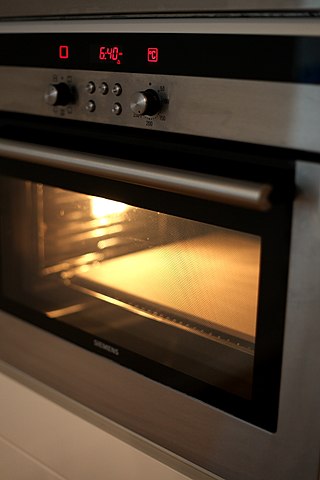
A baking stone is a portable cooking surface used in baking. It may be made of ceramic, stone or, more recently, salt. Food is put on the stone, which is then placed in an oven, though sometimes the stone is heated first. Baking stones are used much like cookie sheets, but may absorb additional moisture for crispier food. A pizza stone is a baking stone designed for cooking pizza.

Rainbow cookie or rainbow cake usually refers to a three-layered almond-flavored Italian-American cookie, but can also refer to any of a number of rainbow-colored confections.

Pineapple tart is a small, bite-size tart filled or topped with pineapple jam, commonly found throughout different parts of Southeast Asia such as Indonesia, Malaysia, Brunei and Singapore in various forms.
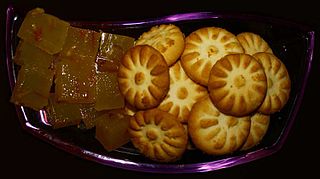
Koloocheh or Kleicha, also known as Persian New Year Bread, is an Iranian stamped cookie or bread. There are many variations on the recipe which spans from the Arabian Peninsula to various diaspora communities including in Eastern Europe, and North America.

Puto seco, also known as puto masa, are Filipino cookies made from ground glutinous rice, cornstarch, sugar, salt, butter, and eggs. They are characteristically white and often shaped into thick disks. They have a dry, powdery texture.

Camachile cookies, also known as quinamunsil, are Filipino ladyfinger cookies that are characteristically shaped like the fruits of the camachile tree. They are traditionally eaten with hot drinks for breakfast or merienda.


















